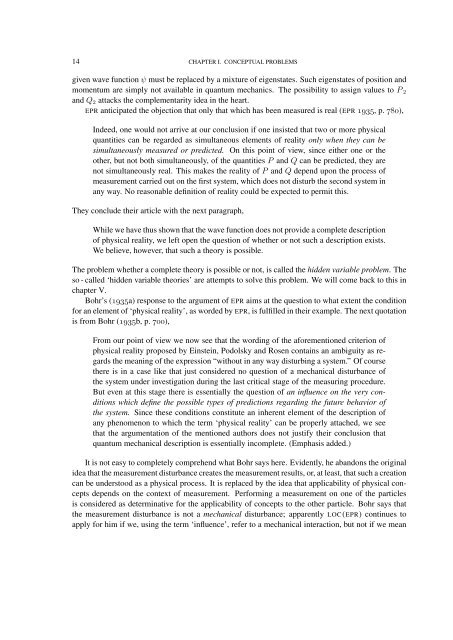FOUNDATIONS OF QUANTUM MECHANICS
FOUNDATIONS OF QUANTUM MECHANICS
FOUNDATIONS OF QUANTUM MECHANICS
You also want an ePaper? Increase the reach of your titles
YUMPU automatically turns print PDFs into web optimized ePapers that Google loves.
14 CHAPTER I. CONCEPTUAL PROBLEMS<br />
given wave function ψ must be replaced by a mixture of eigenstates. Such eigenstates of position and<br />
momentum are simply not available in quantum mechanics. The possibility to assign values to P 2<br />
and Q 2 attacks the complementarity idea in the heart.<br />
EPR anticipated the objection that only that which has been measured is real (EPR 1935, p. 780),<br />
Indeed, one would not arrive at our conclusion if one insisted that two or more physical<br />
quantities can be regarded as simultaneous elements of reality only when they can be<br />
simultaneously measured or predicted. On this point of view, since either one or the<br />
other, but not both simultaneously, of the quantities P and Q can be predicted, they are<br />
not simultaneously real. This makes the reality of P and Q depend upon the process of<br />
measurement carried out on the first system, which does not disturb the second system in<br />
any way. No reasonable definition of reality could be expected to permit this.<br />
They conclude their article with the next paragraph,<br />
While we have thus shown that the wave function does not provide a complete description<br />
of physical reality, we left open the question of whether or not such a description exists.<br />
We believe, however, that such a theory is possible.<br />
The problem whether a complete theory is possible or not, is called the hidden variable problem. The<br />
so - called ‘hidden variable theories’ are attempts to solve this problem. We will come back to this in<br />
chapter V.<br />
Bohr’s (1935a) response to the argument of EPR aims at the question to what extent the condition<br />
for an element of ‘physical reality’, as worded by EPR, is fulfilled in their example. The next quotation<br />
is from Bohr (1935b, p. 700),<br />
From our point of view we now see that the wording of the aforementioned criterion of<br />
physical reality proposed by Einstein, Podolsky and Rosen contains an ambiguity as regards<br />
the meaning of the expression “without in any way disturbing a system.” Of course<br />
there is in a case like that just considered no question of a mechanical disturbance of<br />
the system under investigation during the last critical stage of the measuring procedure.<br />
But even at this stage there is essentially the question of an influence on the very conditions<br />
which define the possible types of predictions regarding the future behavior of<br />
the system. Since these conditions constitute an inherent element of the description of<br />
any phenomenon to which the term ‘physical reality’ can be properly attached, we see<br />
that the argumentation of the mentioned authors does not justify their conclusion that<br />
quantum mechanical description is essentially incomplete. (Emphasis added.)<br />
It is not easy to completely comprehend what Bohr says here. Evidently, he abandons the original<br />
idea that the measurement disturbance creates the measurement results, or, at least, that such a creation<br />
can be understood as a physical process. It is replaced by the idea that applicability of physical concepts<br />
depends on the context of measurement. Performing a measurement on one of the particles<br />
is considered as determinative for the applicability of concepts to the other particle. Bohr says that<br />
the measurement disturbance is not a mechanical disturbance; apparently LOC(EPR) continues to<br />
apply for him if we, using the term ‘influence’, refer to a mechanical interaction, but not if we mean
















